Zero-fee stablecoin public chain aims at the trillion-dollar settlement market.
Author: Delphi Digital
Translated by: Deep Tide TechFlow
The Fastest Growing Settlement Layer for USD
Stablecoins are not just another form of cryptocurrency; they are the closest thing to a global currency in the world. By wrapping the US dollar (and other fiat currencies, albeit to a lesser extent) into a digital form for holders, stablecoins simplify the transfer and settlement processes. Clearing and settlement can be completed in a single atomic transaction and confirmed almost instantly.
This feature makes stablecoins the on-chain version of functional "Eurodollars." Stablecoins are portable dollars that operate outside the traditional banking system, avoiding the friction of correspondent banks, credit card networks, or wire transfers.
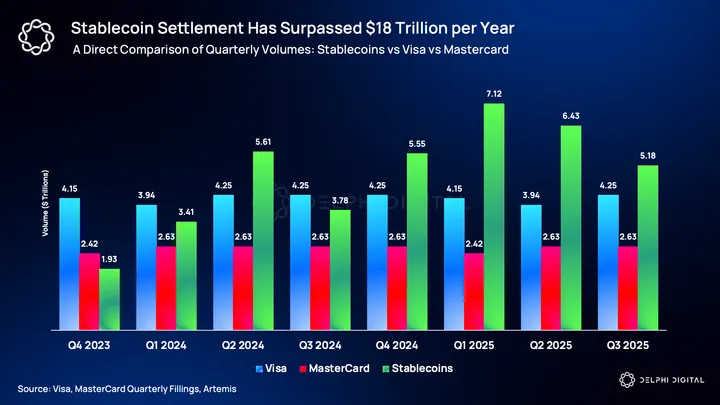
The scale of adoption has been astonishing. By mid-2025, over $245 billion in stablecoins will be circulating on public chains, with approximately 62% being USDT and about 23% being USDC. In 2024, on-chain settlement volume will exceed $15 trillion, surpassing Visa's $14.8 trillion.
Today, one of the main uses of stablecoins is as a quote asset across exchanges (both centralized and decentralized), providing leverage for investors. However, stablecoins have rapidly evolved from a niche settlement layer for traders to a payment channel that rivals large credit card networks. In the first quarter of 2025, stablecoin clearing volume exceeded $7 trillion, briefly surpassing the total of Visa and Mastercard combined. In every subsequent quarter, they maintained an astonishing gap with the cumulative settlement volume of the two major payment processors.
The development trajectories of both are starkly different. Credit card networks continue to grow steadily, but at a slowing pace. In contrast, stablecoins have a much faster compound growth rate, with trading volumes that were nearly invisible a few years ago now rivaling the scale of traditional payment channels.
Initially serving as collateral for cryptocurrency trading, stablecoins have gradually evolved into a flow of funds for remittances, merchant settlements, and B2B payments. Especially in markets where local currencies are unstable or banking infrastructure is weak, the dollar on-chain is not only more functional but also relatively a means of value storage. Compared to pure payment processing networks like Visa and Mastercard, stablecoin networks can support a wider variety of financial activities, which means we should expect the market share of stablecoins to continue to rise in this context.
The US interbank transfer system, ACH, still clears around $20 trillion each quarter, but stablecoins are starting to catch up. Stablecoins were nearly ignored in 2021, but now they process over $7 trillion each quarter, gradually eroding ACH's share of digital dollar settlements.
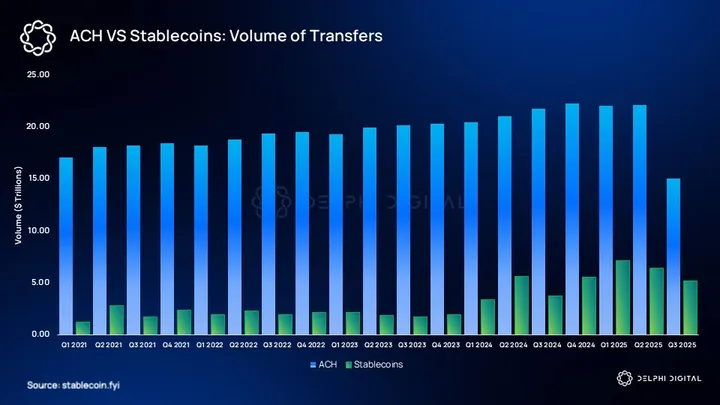
Plasma: Today's Opportunity to Build the Future of Payments
Despite the critical role of stablecoins, they remain second-class citizens on the blockchains that host them. Platforms like Ethereum, Tron, and Solana were designed as general-purpose smart contract platforms, not dedicated currency payment channels. As a result, stablecoin transfers are affected by volatile gas prices, MEV (miner extractable value) attacks, and fee models priced in speculative native tokens. This mismatch leads to inefficiencies: users pay billions of dollars each year for simple ledger updates centered around them.
Plasma completely disrupts this model. It is a Layer-1 blockchain built specifically for stablecoin finance, treating USDT and other fiat-backed tokens as the primary workload of the network, rather than just another application on it. By optimizing consensus, fee policies, and economic incentives to accommodate high-frequency, low-margin traffic, Plasma positions itself as the settlement layer for the global dollar economy. In this way, it intelligently addresses the trillion-dollar opportunities in cross-border payments, remittances, and merchant settlements, which are sensitive to costs and prioritize final speed.
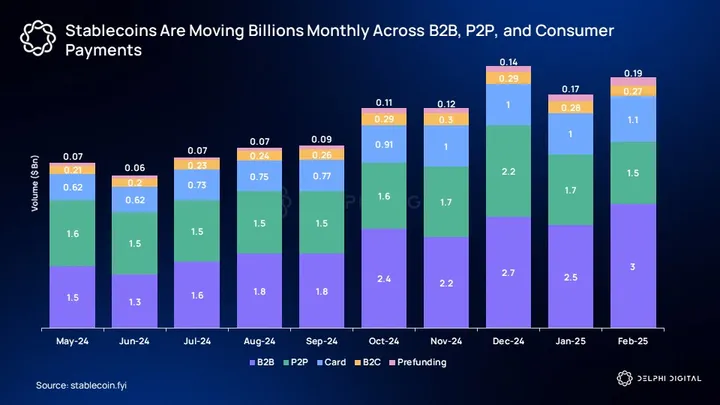
Overview of Plasma Architecture
The design of Plasma draws lessons from a decade of L1 experimentation. Its underlying operation is based on HotStuff's BFT consensus (PlasmaBFT), providing fast finality and high throughput. On the first day of the mainnet launch, TPS will exceed 1,000 TPS, ultimately scalable to over 10,000 TPS. On this basis, it adopts a Reth-based execution layer, ensuring complete equivalence with EVM and compatibility with existing tools and contracts.
Key design choices include:
Stablecoin-centric fee model: USDT transfers incur zero fees, while non-stablecoin transactions follow a modified EIP-1559 burn mechanism, returning value to XPL tokens. This mechanism applies only to transfers, not to other types of transactions, such as exchange trades.
Validator security through XPL staking: XPL serves as Plasma's reserve collateral, ensuring economic security and coordinating long-term incentives.
Consistency of liquidity with USDT: USDT was natively integrated from the genesis, with issuers and trading partners providing instant depth for the settlement pool.
Cross-asset bridge tracks: A native Bitcoin bridge positions Plasma as a place where the two most commonly used on-chain asset classes, BTC and stablecoins, intersect.
Plasma is not about adding another L1 blockchain but rather about how to design a chain around stablecoins to anchor the next phase of global dollar settlement.
Zero-fee USDT Transfers: Plasma's Strategic Breakthrough
One of Plasma's boldest design choices is to make USDT transfers fee-free at the base layer. At first glance, this seems counterintuitive. Blockchains typically profit from transaction fees, and stablecoins, especially USDT, are the highest frequency use case in the current crypto space. Why would a new chain choose to offer its most valuable traffic for free?
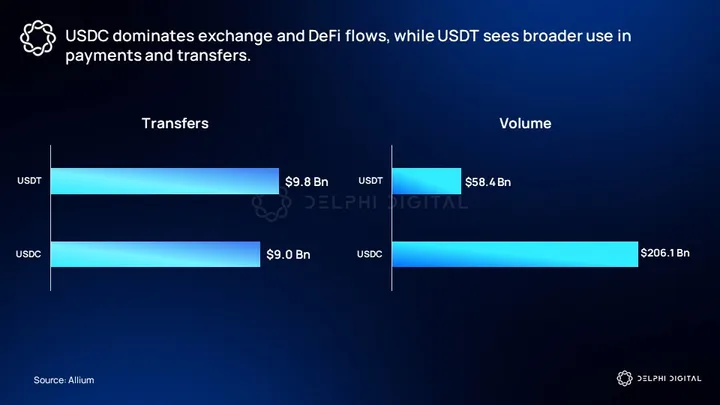
The answer lies in how Plasma constructs value capture. The quarterly settlement volume of stablecoins has already exceeded $10 trillion. The real opportunity is not in the marginal cost of transfers but in becoming the default ledger for these transfers. Just as internet companies offered free email, messaging, and search services to monetize downstream activities supported by these free services, Plasma is leveraging zero-fee USDT transfers as a customer acquisition strategy for global dollar liquidity.
For example, PayPal nurtured its early network by offering free person-to-person payments, later profiting through merchant checkout fees and exchange rate spreads. Google took a similar path, capturing search and app store revenue by distributing the Android operating system for free. Plasma is replicating this strategy in the stablecoin space: offering the most basic services for free to attract traffic, applications, and developers, and then profiting from higher-value layers such as settlement, liquidity, and financial services.
It is important to note that zero-fee transfers apply only to simple USDT send and receive transactions, similar to transferring on Venmo. Any other interactions involving USDT, such as exchanges, lending, or contract calls, still incur regular fees. This exemption is intentionally narrow, designed to make the most frequent and commoditized operations on-chain feel smooth while maintaining the integrity of the validator incentive mechanism and the broader fee model.
The paradox of offering the most commonly used features for free is intentional. By eliminating underlying friction, Plasma aims to become the cheapest and fastest platform for USDT transfers across wallets, exchanges, and settlement channels. For high-frequency participants who are most sensitive to transfer costs (such as market makers, centralized exchange (CEX) exporters, payment service providers (PSPs), and remittance operators), Plasma's appeal is particularly strong.
The ultimate vision: If USDT liquidity begins to concentrate on Plasma, liquidity will deepen, balances will accumulate on-chain, and USDT activity will migrate from a dispersed multi-chain footprint to a closer single gravitational hub.
Plasma does not expect to profit from USDT transfers themselves. The free transfer layer is a breakthrough for attracting traffic into the system, while profitability occurs downstream through DeFi transactions that pay fees, foreign exchange conversions, and settlement services. The long-term bet is simple: XPL will capture value by securing the infrastructure that supports this traffic, rather than taxing simple transfers.
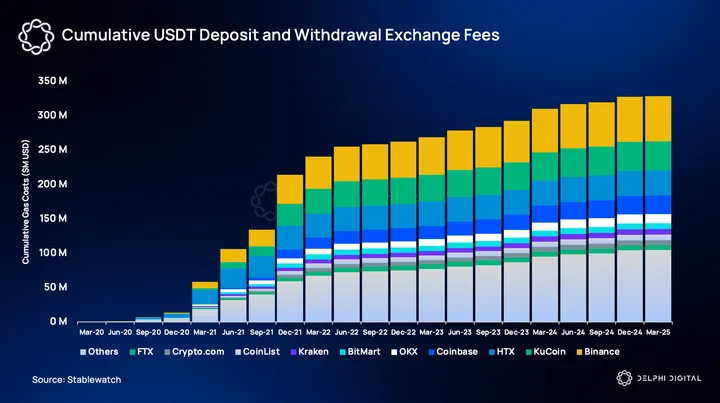
Over the past five years, users have spent over $300 million on deposits/withdrawals of USDT on centralized exchanges (CEX). This strongly demonstrates how free USDT transfers provide a compelling opportunity for users to choose Plasma as their USDT hub over any other chain.
Plasma One: How to Profit from Traffic?
The next question is how to capture and monetize this traffic. This is precisely where Plasma One, a new type of native bank for stablecoins, comes into play.
Plasma One is designed as an entry point for users, merchants, and enterprises. It extends the advantages of the zero-fee transfer base layer into a daily currency experience. Users can save in dollars, earn yields, swipe cards at merchants, and send payments instantly for free. For merchants, Plasma One offers direct USDT settlement, eliminating intermediary and foreign exchange costs. Developers and institutions can also access Plasma's distribution network through Plasma One.
The economic model shifts from taxing each transfer to monetizing the layers above the transfers. Plasma One has the potential to capture value in three ways:
Card exchanges and merchant settlements: Every swipe or payment incurs a fee, just like traditional card networks, but at a lower cost and with broader coverage.
Foreign exchange and conversion spreads: Converting between USDT, local currencies, and other stablecoins naturally generates spreads, which Plasma can capture through its integrated forex system.
Yield capture: User deposits on Plasma One can be transferred to on-chain money markets, with the generated yields shared with users or partially retained by the ecosystem.
As Plasma targets emerging markets where currencies continue to depreciate against the dollar and euro, this value proposition will become even stronger.
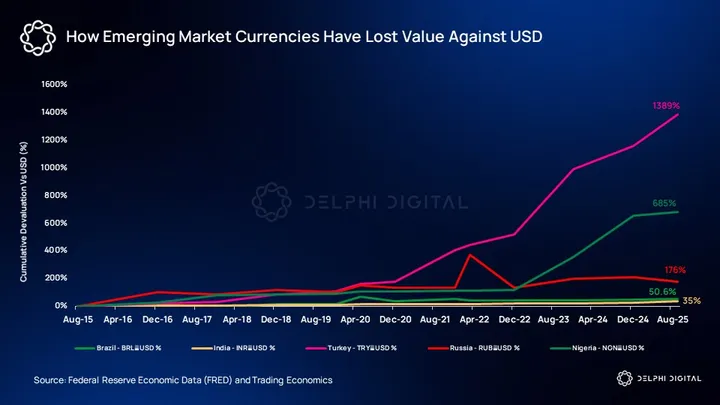
By simultaneously owning the blockchain and a new type of bank, Plasma creates a closed loop between infrastructure and distribution. Zero-fee transfers attract traffic, while Plasma One provides a home for this traffic and monetizes it through people's expectations of banking services—delivered via stablecoin rails.
Plasma's Position in the Stablecoin L1 Competition
In the past year, blockchain projects focused on stablecoins have emerged continuously, with each company realizing that dollar settlements are a killer application for cryptocurrency. Some of these projects, such as Arc and Codex, work closely with Circle and naturally favor USDC, although they remain open to inflows from other stablecoins like USDT. Their promotion primarily focuses on regulatory transparency and institutional adoption, positioning themselves as compliant rails for capital markets.
Other companies, such as Stable, position themselves as platforms for USDT circulation, lacking issuer neutrality. Tempo falls somewhere in between, emphasizing regulated channels and compliance-first integrations with enterprises and payment service providers (PSPs). While these issuer-centric or compliance-focused models can provide strong corporate consistency, they may reform islands that restrict experimentation and composability.
Plasma takes a different stance. By anchoring USDT while maintaining issuer neutrality and full programmability of the EVM, Plasma positions itself as a more convenient platform for DeFi and organic stablecoin applications. It aims to absorb the complex high-frequency traffic that drives real liquidity, such as remittances, trading, and merchant settlements, rather than just serving curated institutional channels.
The quarterly clearing value of stablecoins has reached trillions of dollars; blockchains that can maintain liquidity and composability are more likely to become true settlement hubs. Neutrality, rather than corporate alliances, may be a more solid foundation for capturing the next wave of stablecoin application trends.
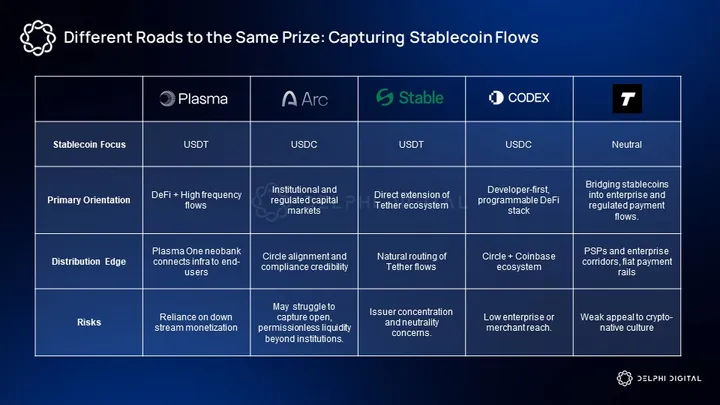
XPL Token Economics
At the core of Plasma is XPL, the native token that powers the network.
XPL is the native token of the Plasma blockchain, similar to ETH on Ethereum and SOL on Solana. XPL can be used as a gas token for transactions and smart contract execution, as well as a staking asset for network security and a reward token for validators.
As mentioned earlier, Plasma's architecture allows end users to make gas-free stablecoin transfers, but any more complex interactions (contract deployment, advanced dApp usage) require XPL as gas or automatic conversion of part of the stablecoin to XPL for fee payment.
Like most Layer 1s, XPL does not have a fixed supply cap and adopts programmatic issuance like ETH or SOL. At the launch of the mainnet Beta, the initial supply of XPL will be 10 billion, with an annual inflation rate of 5% to reward validators. After that, the inflation rate will decrease by 0.5% each year, ultimately stabilizing at 3%.
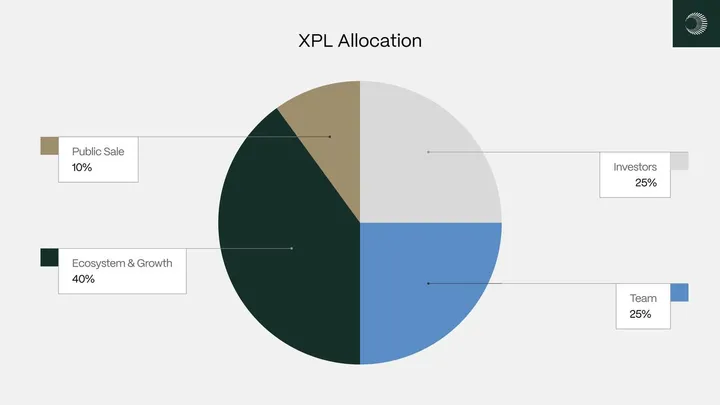
Public sale: 10% (unlocked at TGE for non-U.S. investors, with U.S. investors unlocking on July 28, 2026)
Ecosystem and growth: 40%
Team: 25% (1-year lock-up + 2-year linear release)
Investors: 25% (1-year lock-up + 2-year linear release)
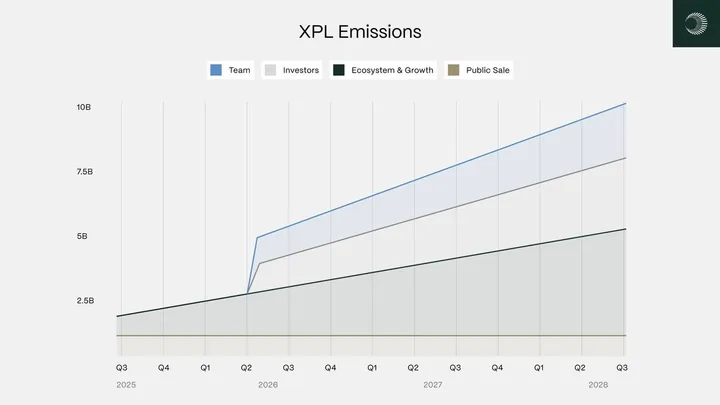
Plasma adopts Ethereum's EIP-1559: the base transaction fee will be burned. Network growth will exert deflationary pressure on token issuance. In practice, high usage may make XPL a net deflationary token.
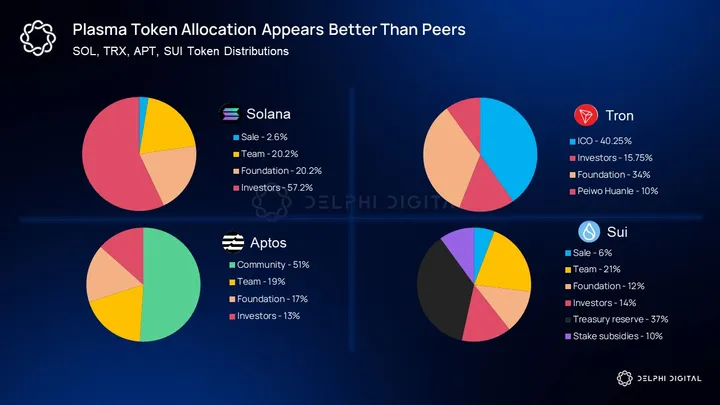
The initial circulating supply at the mainnet launch will include tokens from the public sale (10% minus the allocation for U.S. investors), all unlocked ecosystem tokens (8% immediately unlocked), and possibly a small portion allocated to strategic partners. Team and investor tokens (totaling 50%) will be locked at genesis. Therefore, the initial circulating supply is relatively limited, expected to reach about 18% of the total supply at TGE.
For L1 tokens, token distribution is crucial. While this is just a discussion point for governance tokens, L1 tokens need to consider factors such as public interest, decentralized infrastructure, and commodity value. Aggressive or predatory token distributions will permeate the entire lifecycle of the blockchain ecosystem. From this perspective, XPL's overall token distribution is very healthy compared to other L1 tokens.
It remains unclear how XPL's token distribution compares to more ideal peers like Tempo and Arc. We will continue to monitor as more details are disclosed.
Why XPL is Valuable
Plasma's value proposition is closely tied to the idea of stablecoins as a killer application in the crypto space. As previously mentioned, the on-chain trading volume of stablecoins reached an astonishing $27.6 trillion in 2024, surpassing the total transaction volume of Visa and Mastercard for that year. Cryptocurrency innovation, especially in DeFi, is currently at a bottleneck. Connecting traditional currencies with blockchain rails is key to driving the next phase of innovation.
When evaluating L1 tokens, analysts typically use two frameworks:
Real Economic Value (REV) – Fees + MEV (Maximal Extractable Value). This approach views the token as a stock with a claim on cash flows.
Currency Premium – This method values the token as a currency based on its utility and network effects.
For a new chain like Plasma, initial fee capture is low, especially since Plasma offers zero or near-zero fees to kickstart usage. Therefore, it is unrealistic to value Plasma based on REV. Other new chains like Aptos and Sui have never been assessed by the market under this standard.
The aspect of currency premium is more relevant to XPL at this stage. People value XPL not because it can immediately pay out substantial staking rewards or dividends, but because they anticipate that Plasma will become a crucial infrastructure dominated by stablecoins in the future.
Staking rewards and the deflationary pressure from burns will help gauge this progress and validate this argument. Monetary policy is crucial for L1, helping to establish its perception as an effective store of value. However, a deflationary monetary issuance mechanism is unlikely to become the core direction of Plasma's valuation, especially in the early stages.
The new L1 token market tends to focus more on the potential of this new chain rather than the core fundamentals on day one.
For example, excitement over MoveVM and throughput that can compete with Solana has shifted attention to alternative high-throughput chains like Sui and Aptos—this desire for faster chains drives their valuations more than anything else.
Since Plasma is at the core of the most fundamental use case in cryptocurrency—stablecoins, the primary source of value for XPL will come from its perceived currency premium. As the chain and its ecosystem launch and solidify, we expect REV and core economic metrics to begin to grow as well.
Current Competitive Landscape
USDT is the largest and most liquid stablecoin on centralized exchanges (CEX). USDC is favored in the DeFi space, with numerous integrated projects, serving as a major trading pair for DEX liquidity and showing strong momentum in the payments sector. Despite the expanding design space for stablecoins and increasing market interest, USDT's market share continues to solidify, with supply nearing $200 billion.
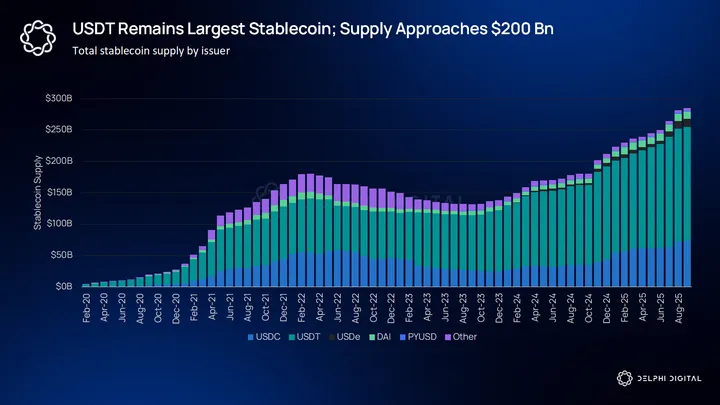
Ethereum has become the primary liquidity hub for stablecoins due to its strong control over DeFi innovation and activity. Although Solana, Aptos, and Sui are gaining attention, these chains have not attracted significant stablecoin liquidity like Ethereum and Tron.
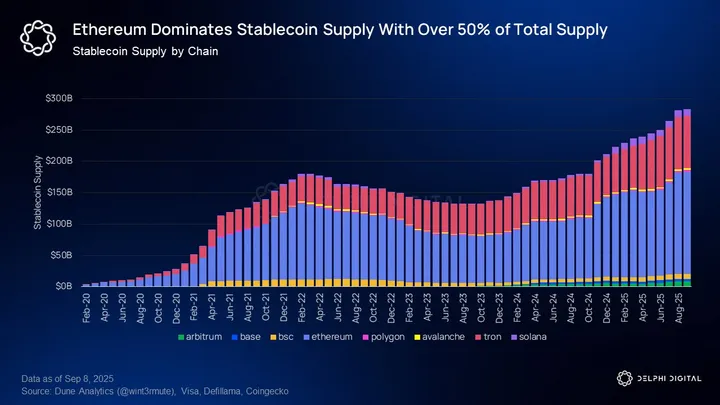
Tron is the second-ranked public chain in terms of stablecoin supply and has become the unofficial public chain for USDT transfers. Aside from USDT, Tron has limited stablecoin and DeFi activity, but its market share is impressive: Tron's USDT supply of $83 billion is very close to Ethereum's $87 billion.
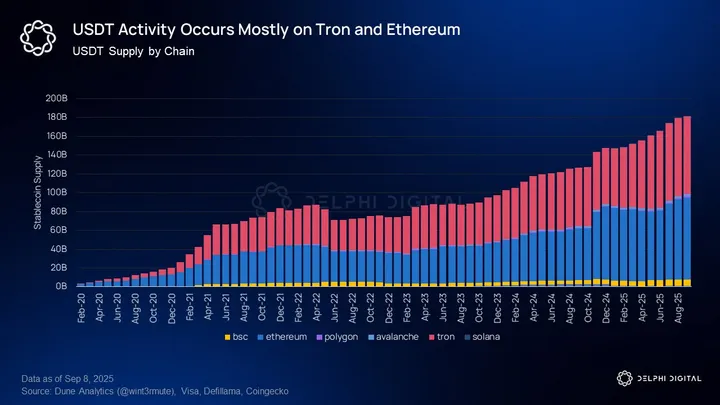
The trading volume of stablecoins is more widely distributed across various ecosystems. Ethereum lags far behind Layer 2 and competing Layer 1s. The trading volumes of stablecoins on Tron, Solana, Base, and BSC are all higher than that of Ethereum. The theory of high throughput is best exemplified here, as the gas fees on the Ethereum mainnet are too high for everyday stablecoin usage. Therefore, Ethereum is primarily used for complex, high-risk DeFi tools.
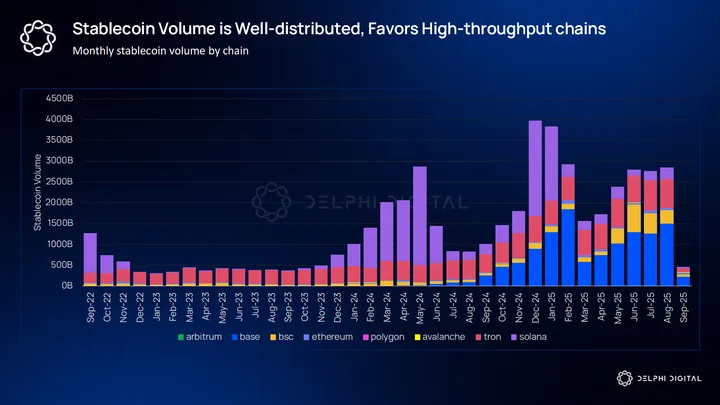
Plasma's zero-fee USDT transfers unabashedly position it as the "killer" of Tron. Although Tron has found a product-market fit for the USDT chain, it has failed to build an active DeFi ecosystem around it, at least not one that matches its $83 billion USDT supply.
Plasma's goal should be to establish partnerships with major DeFi teams to move beyond the niche market of remittance chains while simultaneously gaining TVL and trading volume. This goal has already made significant progress.
Binance Earn on Plasma is a fully on-chain USDT yield product that has committed to investing $1 billion before the mainnet Beta launch. Users can lock USDT through Binance Earn, which will be deployed on the infrastructure rails operated by Plasma to generate yields. This product is similar to the native USDC yield on Base.
Additionally, Plasma has announced partnerships with Aave, Fluid, Wildcat, Maple Finance, and USD.AI. These partnerships strike a balance between crypto-native applications (Aave, Fluid, USD.AI) and fintech applications aimed at institutions (Maple Finance, Wildcat, USD.AI). Positioning Plasma as a blockchain where users can conduct business as usual, while fintech applications have a better chance of achieving product-market fit, is a reliable strategy for gaining sustained usage and building a true moat.
Theoretical Valuation Model
For Plasma, the most reasonable comparisons are Stable, Arc (Circle), and Tempo (Stripe). However, these blockchains do not yet have liquidity. Currently, high-throughput, DeFi-dominant blockchains like Tron, Solana, Ethereum, Aptos, and Sui are the best choices.

REV is an intuitive metric that serves as a meaningful mental model for understanding Layer 1 value capture. However, it is clearly almost unrelated to market pricing and does not correlate with current Layer 1 valuations. The appeal of Solana's REV data lies in its ecosystem attracting numerous active users. TVL remains the most commonly used metric for measuring blockchain attractiveness, while stablecoin supply provides a good supplementary data point.
These two metrics show reasonable consistency in the valuations of the sample group, with multiples below 15, typically in the mid-single digits range.
Tron has a niche use case, with limited growth prospects due to low DeFi penetration and a lack of the technical premium that next-generation blockchains typically possess. Therefore, its 0.4 stablecoin price-to-supply ratio may be somewhat anomalous.
By making reasonable expectations about how the market will respond to varying degrees of traction, we can conduct scenario analysis for Plasma's XPL valuation.
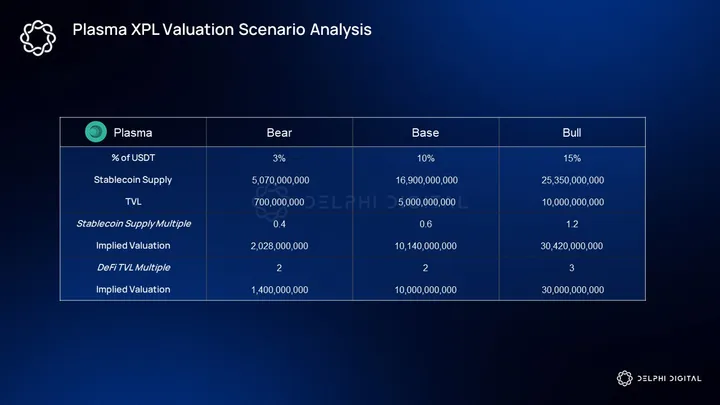
Our bear, baseline, and bull cases assume market shares of 3%, 10%, and 15% for USDT supply, respectively.
It is important to note the potential flaws in the assumptions:
Downside risk: There may be saturation in the enterprise chain narrative, where these chains influence each other's usage and attention, compressing multiples. To account for this, we use a lower stablecoin supply multiple in the bear case, employing Tron's 0.4 anomaly.
Upside potential: Our USDT market share assumes a fixed market share. For instance, Tether will not issue additional USDT, and Plasma itself has no impact on new USDT issuance. Both scenarios are unlikely to occur, making this an extremely conservative assumption. If market share continues to grow at the current pace, Plasma could achieve similar results even at lower market share numbers.
The pre-market valuation of XPL largely aligns with this network valuation approach. The upside potential here primarily relies on driving narratives and divergent appeal through partnerships and milestones. The biggest risk is a flood of similarly branded chains entering the market. Plasma's goals are attractive, and the narrative it embodies is the cornerstone of the cycle.
Conclusion
The development of Tether and Circle as issuers, the absolute number of stablecoins used on on-chain platforms, the emergence of new era products like Ethena and Wildcat, and the widespread acceptance of traditional payment companies like PayPal and Stripe all tell us one thing: the opportunity for stablecoins is undeniable.
At the same time, it is necessary to continue to uphold the core spirit of the crypto space. Permissionless usage, decentralization, and grassroots community building remain its core elements. With the rise of stablecoin L1s (some of which may emerge in the form of company-adopted blockchains), Plasma seems to be in the best position in this regard. With strong first-day integration capabilities while maintaining a certain distance from centralized operators, Plasma perfectly combines the advantages of stablecoins with the concept of on-chain capital markets.
The L1 battle has increasingly become commoditized. High throughput has become a basic requirement. The real war lies in ecosystem building and user acquisition.
Plasma firmly believes that the cost of stablecoin transfers should ultimately trend toward zero, with its true value lying in facilitating high-risk activities such as lending/financing and trading. In short, Plasma's true business model is rooted in becoming the center of stablecoin liquidity. One of the simplest ways to achieve this goal is to provide users with high-frequency usage scenarios (such as simple payments/transfers) for free.
From Plasma One and the various DeFi protocols soon to be deployed on-chain, Plasma views distribution as its true source of differentiation, not just technical architecture. As the world's acceptance of stablecoins increases, Plasma is committed to becoming one of the leading platforms where developers and users gather around stablecoin products.
免责声明:本文章仅代表作者个人观点,不代表本平台的立场和观点。本文章仅供信息分享,不构成对任何人的任何投资建议。用户与作者之间的任何争议,与本平台无关。如网页中刊载的文章或图片涉及侵权,请提供相关的权利证明和身份证明发送邮件到support@aicoin.com,本平台相关工作人员将会进行核查。




